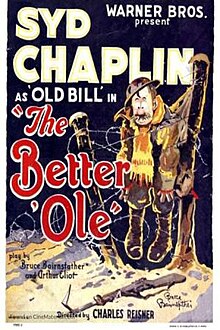
Vitaphone was a sound film system used for feature films and nearly 1,000 short subjects made by Warner Bros. and its sister studio First National from 1926 to 1931. Vitaphone is the last major analog sound-on-disc system and the only one that was widely used and commercially successful. The soundtrack is not printed on the film, but issued separately on phonograph records. The discs, recorded at 33+1⁄3 rpm and typically 16 inches (41 cm) in diameter, are played on a turntable physically coupled to the projector motor while the film is projected. Its frequency response is 4300 Hz. Many early talkies, such as The Jazz Singer (1927), used the Vitaphone system. The name "Vitaphone" derived from the Latin and Greek words, respectively, for "living" and "sound".

Don Juan is a 1926 synchronized sound American romantic adventure film directed by Alan Crosland. It is the first feature-length film to utilize the Vitaphone sound-on-disc sound system with a synchronized musical score and sound effects, though it has no spoken dialogue. The film is inspired by Lord Byron's 1821 epic poem of the same name. The screenplay was written by Bess Meredyth with intertitles by Maude Fulton and Walter Anthony.

Captain Charles Bruce Bairnsfather was a prominent British humorist and cartoonist. His best-known cartoon character is Old Bill. Bill and his pals Bert and Alf featured in Bairnsfather's weekly "Fragments from France" cartoons published weekly in The Bystander magazine during the First World War.

Old Bill is a fictional character created in 1914–15 by cartoonist Bruce Bairnsfather. Old Bill was depicted as an elderly, pipe-smoking British "tommy" with a walrus moustache. The character achieved a great deal of popularity during World War I where it was considered a major morale booster for the British troops. Old Bill and his younger troopmate little Alphie were private infantrymen in the British Expeditionary Force.

The Better 'Ole, also called The Romance of Old Bill, is an Edwardian musical comedy with a book by Bruce Bairnsfather and Arthur Elliot, music by Herman Darewski, and lyrics by Percival Knight and James Heard, based on the cartoon character Old Bill, an infantryman, drawn by Bairnsfather. In the musical, Old Bill intercepts a spy's plan to destroy a bridge, trapping a French regiment after they cross it. Bill saves them by blowing up the bridge before they pass; his actions are misunderstood, however, and he is arrested for disobeying orders and holding an enemy document. After Victoire explains the situation, Bill is released and given a medal.
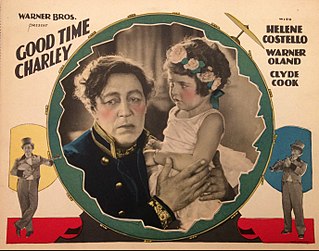
Good Time Charley is a 1927 American synchronized sound drama film produced and distributed by Warner Bros. and directed by Michael Curtiz. While the film has no audible dialog, it was released with a synchronized musical score with sound effects using the Vitaphone sound-on-disc process. It was considered to be a lost film. However, as of January 2021, the film is listed as extant at the Library of Congress.
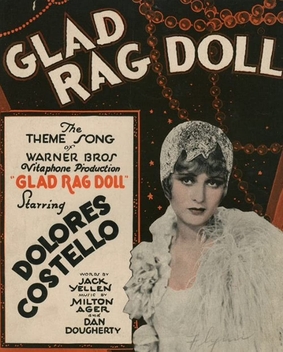
Glad Rag Doll is a 1929 American sound part-talkie pre-Code drama film directed by Michael Curtiz, and starring Dolores Costello, Ralph Graves, and Audrey Ferris. In addition to sequences with audible dialogue or talking sequences, the film features a synchronized musical score and sound effects, along with English intertitles. The soundtrack was recorded using the Vitaphone sound-on-disc system. This is one of many lost films of the 1920s, no prints or Vitaphone discs survive, but the trailer survives. The film's working title was Alimony Annie, but was changed match the title of the theme song. The theme song is entilted Glad Rag Doll both played and sung throughout the soundtrack.

Sailor Izzy Murphy is a 1927 synchronized sound comedy-drama film released from Warner Bros. Pictures starring George Jessel, Audrey Ferris, Warner Oland and John Milijan. While the film has no audible dialog, it was released with a synchronized musical score with sound effects using the Vitaphone sound-on-disc process. The film was a follow-up to a previous film starring Jessel titled Private Izzy Murphy. The premiere was set for October 8, 1927, at Warners' Theater, two days after the premiere of The Jazz Singer, the first talking film (part-talkie) starring Al Jolson.
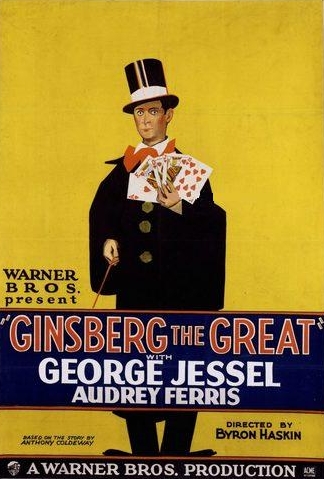
Ginsberg the Great is a lost 1927 synchronized sound film starring George Jessel in the period in which he made films with Warner Bros. While the film has no audible dialog, it was released with a synchronized musical score with sound effects using the Vitaphone sound-on-disc process.
Vitaphone Varieties is a series title used for all of Warner Bros.', earliest short film "talkies" of the 1920s, initially made using the Vitaphone sound on disc process before a switch to the sound-on-film format early in the 1930s. These were the first major film studio-backed sound films, initially showcased with the 1926 synchronized scored features Don Juan and The Better 'Ole. Although independent producers like Lee de Forest's Phonofilm were successfully making sound film shorts as early as 1922, they were very limited in their distribution and their audio was generally not as loud and clear in theaters as Vitaphone's. The success of the early Vitaphone shorts, initially filmed only in New York, helped launch the sound revolution in Hollywood.

A Dog of the Regiment is a 1927 American synchronized sound drama film directed by D. Ross Lederman. While the film has no audible dialog, it was released with a synchronized musical score with sound effects using the Vitaphone sound-on-disc process. This film is presumed lost. According to Warner Bros records the film earned $188,000 domestic and $59,000 foreign.

The Man and the Moment is a formerly lost 1929 sound part-talkie romantic comedy film directed by George Fitzmaurice and starring Billie Dove. In addition to sequences with audible dialogue or talking sequences, the film features a synchronized musical score and sound effects along with English intertitles. The soundtrack was recorded using the Vitaphone sound-on-disc system. The film survives in a copy of the International Sound Version. The sound of the domestic part-talkie version was synchronized to the surviving print of the international sound version. Because of this, many scenes feature intertitles shown immediately after the spoken dialogue conveying the same words. The talking sequences on the international sound version were muted with music and intertitles were inserted to convey the dialogue replaced in the appropriate foreign language. Therefore, intertitles were left in the talking sequences during the restoration to maintain synchronization with the Vitaphone soundtrack. The story is from a 1914 novel by Elinor Glyn, the famous novelist. The film was produced by Richard A. Rowland and released by First National Pictures. A British silent film had been film of the same story in 1918.
The Greyhound Limited is 1929 part-talkie talkie crime drama and railroad theme film directed by Howard Bretherton and starring Monte Blue. In addition to sequences with audible dialogue or talking sequences, the film features a synchronized musical score and sound effects along with English intertitles. The soundtrack was recorded using the Vitaphone sound-on-disc system. The film was produced and distributed by Warner Bros.. The film is a follow-up to the 1927 film The Black Diamond Express.
Caught in the Fog is a 1928 American sound part-talkie thriller film directed by Howard Bretherton and written by Charles R. Condon and Joseph Jackson. In addition to sequences with audible dialogue or talking sequences, the film features a synchronized musical score and sound effects along with English intertitles. The soundtrack was recorded using the Vitaphone sound-on-disc system. The film stars May McAvoy, Conrad Nagel and Mack Swain, and features Hugh Herbert, Charles K. Gerrard and Émile Chautard. The film was released by Warner Bros. on August 25, 1928.

Five and Ten Cent Annie is a 1928 American sound part-talkie comedy film directed by Roy Del Ruth and starring Louise Fazenda, Clyde Cook and William Demarest. In addition to sequences with audible dialogue or talking sequences, the film features a synchronized musical score and sound effects along with English intertitles. The soundtrack was recorded using the Vitaphone sound-on-disc system.
The Little Wildcat is a 1928 American sound part-talkie comedy drama film directed by Ray Enright and starring Audrey Ferris, James Murray and Robert Edeson. In addition to sequences with audible dialogue or talking sequences, the film features a synchronized musical score and sound effects along with English intertitles. The soundtrack was recorded using the Vitaphone sound-on-disc system.
The Fortune Hunter is a lost 1927 synchronized sound film comedy directed by Charles Reisner and starring Syd Chaplin. It is based on the 1909 Broadway play The Fortune Hunter by Winchell Smith. While the film has no audible dialog, it was released with a synchronized musical score with sound effects using the Vitaphone sound-on-disc process. The film was produced by Warner Brothers.
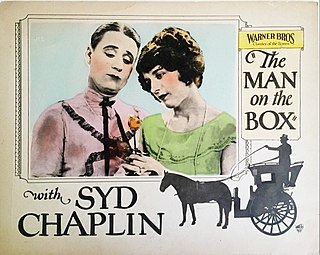
The Man on the Box is a 1925 American comedy film directed by Charles Reisner and written by Charles Logue. It is based on the 1904 novel The Man on the Box by Harold MacGrath. The film stars Sydney Chaplin, David Butler, Alice Calhoun, Cathleen Calhoun, Theodore Lorch, and Helene Costello. The film was released by Warner Bros. on October 11, 1925.

The Missing Link is a 1927 American synchronized sound comedy film directed by Charles Reisner and starring Syd Chaplin, Ruth Hiatt and Tom McGuire. While the film has no audible dialog, it was released with a synchronized musical score with sound effects using the Vitaphone sound-on-disc process. The title of the film is a reference to the so-called "missing link" that connects man and the ape.

The Royal Rider is a 1929 American sound Western film directed by Harry Joe Brown and written by Sylvia Bernstein, Jacques Jaccard and Leslie Mason. While the film has no audible dialog, it was released with a synchronized musical score with sound effects using the Vitaphone sound-on-disc sound process. The film stars Ken Maynard, Olive Hasbrouck, Philippe De Lacy, Theodore Lorch, Joseph Burke and Harry Semels. The film was released by Warner Bros. on February 17, 1929.
